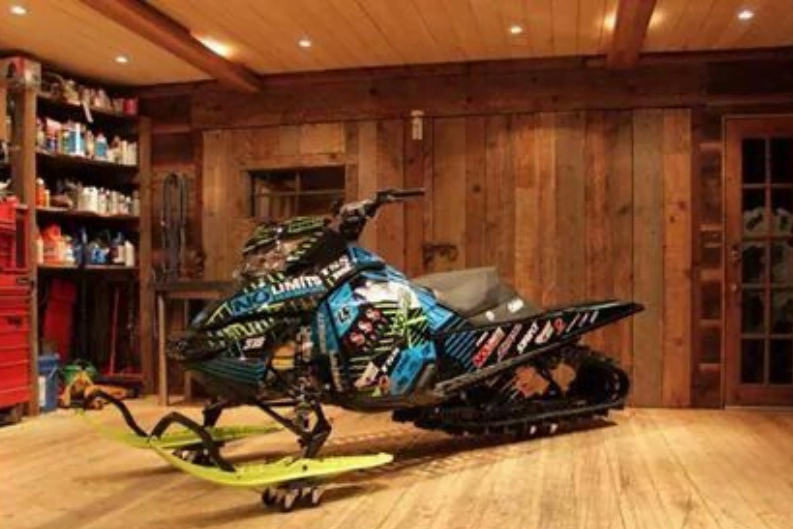Snowmobile Storage | Off Season Prepration
Are you worried about your snowmobile storage? Don’t worry we know everything that you need to know before storing your snowmobile. Another wonderful season of riding has come and gone and it’s time to move on to our summer hobbies. When there’s more mud and dirt on the trails than snow, it’s time to start getting your snowmobile ready for its long summer nap.
If you will not protect your snowmobile from the elements, they degrade. Fuel hoses harden, seat fabrics crack, and rust forms on internal engine components. Corrosion forms in the rear suspension, which causes parts to bind. Decals crack and peel, and the shiny finish on the tunnel slowly turns into a dull, chalky layer of ‘blah.’ Snowmobiles deserve better.
Best Place for Snowmobile Storage
Where you should store your snowmobile for better condition? Many owners let their snowmobiles in a place where there are a lot of outer elements. This is not the right place for your snowmobile to get stored. Let’s jump in to know the best place for snowmobile storage.
For snowmobile storage, it is recommended to keep your snowmobile in a dry indoor area, like a shop or garage. This will protect your machine from moisture and sun damage.
To keep your snowmobile clean while it’s not in use, consider covering it with the cover or shop blanket. This will help prevent dust and debris from accumulating in hard-to-reach areas, keeping your snowmobile in top condition for your next ride.
6 Tips for Snowmobile Storage
Here are some tips for properly preparing your snowmobile for storage to help ensure it’s in good shape for next winter. You don’t have to do these steps in order, but I would recommend you complete each and every one.
1. Wash your Snowmobile
Proper snowmobile storage requires thorough cleaning before putting it into hibernation for the summer. After a season of use on the trails or in transit, it’s crucial to wash away all the accumulated dust and grime. There are two options for cleaning are following.
Ensure that all hard-to-reach areas, especially those with stuck mud or grit, are addressed. Additionally, allow enough time for the snowmobile to dry completely before covering it for storage.
2. Stabilize the Fuel

The fuel of your snowmobile can degrade over time and may rust engine parts. So pouring a fuel stabilizer into the tank will help prevent this. Read the directions on the bottle of the fuel stabilizer to find out how much to use based on how much gas is in the tank. Run the engine for a few minutes after pouring it in to help ensure treated fuel is flowing throughout the system.
3. Fog your Snowmobile’s Engine
This is a step that some snowmobile owners do and others do not. Coating the inside of your snowmobile’s engine with fogging oil may help protect your crankshaft bearings, connecting rods, and other engine parts from air and moisture.

Before fogging the engine you’ll need to open up the airbox of the snowmobile after that you have to start the engine and spray the fogging spray into the carb openings for around 5-10 seconds. Once you have fogged, put the airbox back on your snowmobile.
Fogging the engine puts a layer of oil over many of the internal components. This is typically only done on 2-stroke engines, so check with your manufacturer if you ride a 4-stroke snowmobile before fogging.
4. Grease the Chassis
Snowmobiles built within the past few years generally have fewer grease zerks than earlier machines. You might find two or three in the rear suspension and a couple on the front end. To help keep the suspension and steering systems working smoothly, pump a few shots of grease into each zerk on the chassis.

This pushes out water from within the small shafts and suspension tubes and fills those small voids with fat so moisture won’t collect inside the lines during early spring and late fall temperature cycles.
5. Get your Sled Off the Ground
If you’re storing your snowmobile in a garage or shed, you may want to place a few mothballs under the hood and on the tunnel to help keep out rodents and other varmints.
Consider putting a jack stand under the rear bumper and unhooking the springs. Set the front end of the chassis on a wooden box so it hangs freely, too. This can relieve tension on the track and suspension, helping them to last longer.
6. Cover your Snowmobile
Once you have completed all the steps, it’s time to cover up the sled. Again, an indoor location is better than an outdoor one because it will be cooler and eliminate moisture. If you have a garage, you can place a snowmobile cover, blanket, or tarp over the sled.

If you do have to store your sled outside, do it properly. Rigging up a tent or tarp to block out sun and moisture is a good idea—something to provide shade and deflect rain. Then you can put a snowmobile cover over your machine. Just make sure it is well secured.
Conclusion
Snowmobile storage is one of the most vital segments of any snowmobiler’s life. A little effort can go a long way, and these simple steps will help you maximize the value of your sled while securing it works appropriately when you want it to in the winter. Otherwise, you will shorten the machine’s lifespan and create possible maintenance issues. So if you want your snowmobile to stay fit and perform well in all the upcoming seasons then you have to take care of your beloved sled.







